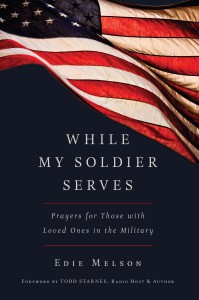My husband always says, “My wife has experienced more deployments than most people I know.” That’s because he counts his two to Iraq and our son’s, (one to Iraq, one to Afghanistan), as ALL MINE.
So I’m excited to welcome Edie Melson as she describes her devotional for military families–this would make a great gift for them as Memorial Day approaches.
them as Memorial Day approaches.
Here is the link for preorder. The price is reduced and you receive a free ebook with an additional 15 prayers.
www.WhileMySoldierServes.com
Thousands of families send loved ones off to fight on a daily basis. These families spend a lot of time living in a world out of control. This kind of stress can take an incredible toll, but there is hope. When we feel helpless, we can take our fears to the One who loves us more than anything and holds the universe in His hands.
In this book you’ll find the words to usher you into His presence. These prayers are a place to visit again and again as you take your own fears to God. They’re just a starting point, written to help you find your own voice as you call out on behalf of the one you love.
As the mother of a frontline infantry Marine, Edie Melson lived this book before she wrote it. Edie understands what it is to face adversity and come out triumphant on the other side. Her years as a wife, mother, and ministry leader have given her a unique perspective to reach out
to others facing the same struggles.
She’s the Military Family Blogger for Guideposts.org, social media director for several writing websites, and a popular ministry and conference speaker. Connect with her on her blog, The Write Conversation, Twitter, and Facebook.
Blooming in Adversity
I’ve come to realize that the seeds of faith begin their journey to the light, in the dark. As the mother of a frontline infantry Marine, I’ve been through the painful process of blooming in adversity.
Neither I nor my husband come from a military family, so our son’s decision to enlist straight after high school caught us off guard. We weren’t ashamed or disappointed in him, although we were worried about where this decision could take him. But we could see his sincere desire to follow God’s leading and knew that wherever this road led, God would see him through.
But as he got ready to leave for his first deployment in Iraq, all those thoughts of faith and how God would take care of him fled. I found myself engulfed in a terror so deep it colored every corner of my world a murky gray.
Throughout the last couple days, I was overcome with fear and uncertainty. As we sat down to eat, I couldn’t help but wonder if this was the last time I’d share a meal with him. As he posed for a picture with his brothers, in the back of my mind was the fear that this would be the last picture I’d ever have of him. All through that time, the what-ifs continued to crowd out the faith I thought I had.
Then he was gone—half a world away—fighting an enemy whose main focus was on killing him. It was during those deployments that I learned about darkness of the heart. I wanted to protect him, I ached to shield him from what I knew he was experiencing, but I couldn’t. So I did the one thing I could do. It became my course of last resort because I was at the end of my own strength.
I prayed.
And I prayed.
And I prayed some more.
I learned to take my overwhelming fear to the only One who could protect him. And I left my son in God’s hands. The prayers weren’t pretty. Often times they weren’t even words. They truly were the groanings we read about in Romans 8:26-27.
I didn’t realize it at the time, but I was like a seed, planted deep in the ground, surrounded by darkness, by rough, rocky soil, pressing in on all sides crushing the life from me. But through that incredible pressure, the shell of my own strength fell away, and I slowly began to push toward the light that I knew lay just beyond the darkness.
And my last resort became my strength, the first place I turned. Instead of praying in desperation, I began to pray in confidence. When the fears threatened to overwhelm me, I learned to lean into God, instead of turning in on myself.
The final harvest of that time of darkness is coming to fruition May 12, just after Mother’s Day. It’s a book of prayers for those with loved ones in the military, While My Soldier Serves. How I longed for just such a book during that dark time. Now God has taken my time of darkness and is shining it as a light for those who are also facing the incredible stress of having a loved one at war.
I can say with confidence, never doubt that God will bring a harvest of joy, no matter how dark the days you’re facing now.
I’d love to know how you get through the dark times and find a way to bloom. Be sure to leave your thoughts in the comments section below.
Edie promises to send a book to one fortunate commentator when they arrive, so please leave your e-mail address. Thanks for stopping by!


















